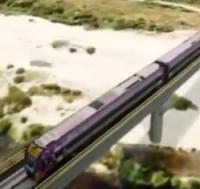The report by consulting engineering firm Aurecon found that the incident can be attributed to a failure in the design of the pedestrian and cycling path.
On 18 January 2017, the Department of Planning, Transport & Infrastructure became aware of girder dislodgement on the cycling and pedestrian overpass. As a result, the road below was temporarily closed to traffic while the structure was stabilised.

Temporary stablising tiebacks were fitted straight after the incident
On 23 January, the state government appointed Aurecon to complete a review (link opens in new tab). Aurecon, which had no involvement with the construction of the overpass, was commissioned to conduct a detailed investigation into the cause of the incident and develop a remediation proposal.
The path was built under a design and construct contract with the government in 2009 by McConnell Dowell, and was designed for McConnell Dowell by engineering firm Aecom, and certified by Wallbridge & Gilbert Consulting Engineers.
Copies of the report have been provided to the consortium of companies who designed and built the path. They will now have an opportunity to respond, after which the state government will work through the report’s findings and deal with issues of liability.
Separately, Aurecon has also been tasked with designing a permanent solution for the pedestrian and cycling path, as well as to conduct a comprehensive review of the government bridge maintenance and inspection regimes.
The report found that the incident can be attributed to the failure of the design to make adequate allowance for out-of-balance effects. This resulted in girders tilting sufficiently to render the bearing restraint system ineffective and essentially free the bearings, allowing them to “walk” out of their design position.
The report states: “Once the bearings were free to move, we believe the mechanism for the movement is due to cyclic ongoing wind load effects on the anti-throw screen, coupled with a constant lateral force due to out-of-balance self-weight effects, promoting a caterpillar movement of the bearing. Lateral movement would then have occurred incrementally over a period of time, until the bearings had moved sufficiently for the girder to lose support.”
Aurecon has advised that other parts of the pedestrian and cycling path are exhibiting signs of this phenomenon, with noticeable bearing deformation, girder rotation and cracking of the keeper walls.
The report makes four recommendations to minimise any further damage to the cycling and pedestrian overpass and recommend what is required to return the path to full working order:
- the anti-throw screens should be removed from the bridge, in order to reduce the lateral loading on the bearing system;
- a monitoring system of all spans should be set up to measure further ongoing movement, and alert the need for appropriate action;
- a design of remediation measures should be undertaken to all spans;
- repair the damaged concrete headstocks should be undertaken, along with upgrade and replacement of failed outer keeper walls at all piers.
Work is already under way to implement the recommendations.
Transport and infrastructure minister Stephen Mullighan said: “I am pleased to have received such quick, thorough and independent advice about such a concerning issue with this cycling and pedestrian path. I have been reassured from the advice I have received that the problems with this bridge are not expected to be experienced elsewhere as the design on a single concrete “Super-T” structure and the supporting bearing arrangement is a design that has not been used elsewhere on our other bridges.
“Nonetheless, I have ordered a full review of all of our 1,500 road and rail bridges to ensure that the public can remain confident in these structures."





